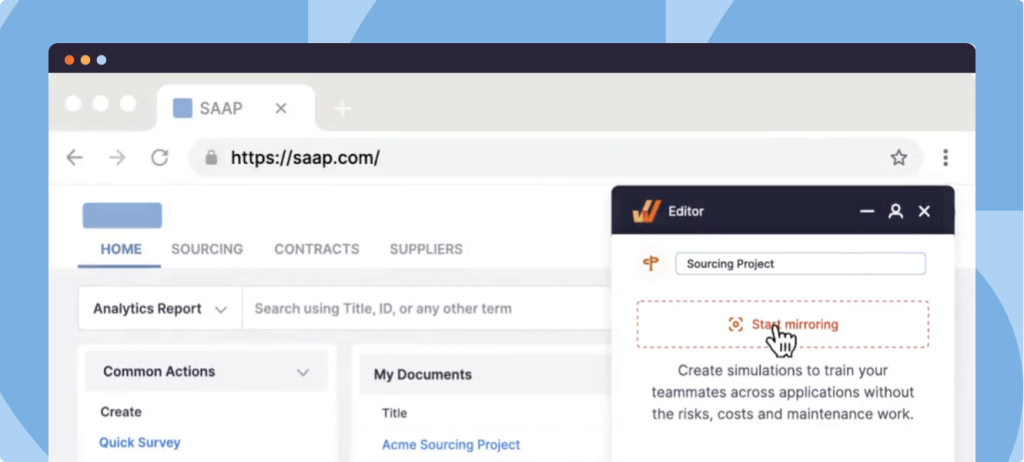As performance expectations rise and attention spans become shorter and shorter, businesses need to adapt corporate L&D strategies to match the needs of teams. In 2025, more traditional employee training methods just don’t deliver the retention rates businesses need.
To overcome these challenges, organizations are incorporating microlearning platforms into L&D initiatives to keep employees engaged throughout training and emerge with long-lasting knowledge.
Microlearning breaks down training content into bite-sized educational modules that don’t overload learners–they simply provide information in a more manageable volume and format. These modules can be embedded into software employees use every day to help them learn within the flow of work.
As organizations across the world have tapped into the benefits of microlearning, many dedicated microlearning platforms have entered the market. As of 2025, the United States microlearning market has reached 2.96 billion and is expected to soar to over 5 billion in the next five years. This software enables short, burst-style learning experiences that improve knowledge retention, drive skills development, and increase employee performance.
In this article, we’ll define microlearning platforms, explain what makes them so effective, and explore twenty of the best microlearning platforms to integrate into your L&D technology stack.
Top 20 Microlearning Platforms in 2025
What Are Microlearning Platforms?
Microlearning platforms are L&D tools that deliver bite-sized learning experiences to employees. In just 3-5 minutes, employees receive short, focused training content. These lessons can be accessed from a learning platform, and now are more commonly embedded into employees’ daily tasks and workflows.
Microlearning platforms are centralized applications that allow L&D teams to easily create and distribute microlearning modules for employees while tracking their effectiveness through user analytics.
20 Best Microlearning Platforms
Let’s break down each software vendor to showcase how they enable microlearning experiences for employees and other types of learners:
1. Whatfix
- G2 Rating: 4.6 out of 5
- Price: Contact for pricing details
Whatfix provides two major platforms that enable microlearning: its digital adoption platform (Whatfix DAP) and its simulation training software (Whatfix Mirror).
Whatfix Mirror allows L&D teams to easily clone applications to create sandbox training environments for employees to learn via hands-on training, in an interactive, risk-free setting.
Whatfix DAP enables software end-users with engaging in-app onboarding experiences, software training, and reinforcement learning, all in the flow of work with contextual Flows, Task Lists, Smart Tips, Field Validations, and Self Help. This empowers end-users with real-time, role-based guidance and support at the moment of need, driving process adoption, workflow governance, and overall employee productivity.

By dividing learning and IT enablement content into small, micro-byte sizes, end-users are enabled with the contextual support they need to take full advantage of mission-critical enterprise software and its contextual workflows (ie, CRMs, HCMs, ERP, etc.)
Whatfix also has LMS integration capabilities with all popular platforms and is the only DAP that is both xAPI and SCORM compliant.

With Whatfix Analytics, you can also analyze end-user behavior and track custom User Action events to identify areas of digital friction across your different end-user types or roles. Use these insights to make data-driven improvements to your digital workflows and overcome these friction areas with new in-app guidance and support experiences.
Key features:
- No-code in-app content creation tools
- Self-help knowledge base creation
- Application sandbox creation tools with Whatfix Mirror
- Powerful user analytics
2. SafetyCulture Training (formerly Edapp)
- G2 Rating: 4.7 out of 5
- Price: Free for up to 10 learners
SafetyCulture Training (previously known as EdApp) is a free microlearning platform with an integrated authoring tool. With features such as spaced repetition, gamification, rewards, and analytics, the platform makes learning fun and engaging, which in turn helps improve retention and embed knowledge.
SC Training enables mobile learning that brings benefits such as push notifications for lesson reminders, cloud distribution, and translation, plus the ability to deliver microlessons directly to learners’ pockets.
Key features:
- AI content creation
- Extensive, editable course library
- Gamification
- Learning assessment tools
3. iSpring Learn
- G2 Rating: 4.6 out of 5
- Price: $3.75 – $6.64/user
iSpring Learn allows users to create a microlearning program and track results in just one day, without headaches, fine-tuning complex settings, or involving IT staff.
With this software, you can create training material from existing content, such as videos, slides, or articles. iSpring has a built-in authoring tool that can be used to create responsive microlearning courses with knowledge checks that work perfectly from a smartphone or desktop.
Key features:
- Extensive content creation tools
- Training management and performance appraisal
- Custom development plans
- Portal customization
4. 7taps
- G2 Rating: 4.8 out of 5
- Price: $0.00 – $99.00/month
7taps facilitates content creation, allowing L&D teams to create and deliver engaging micro-courses in just 15 minutes. This software helps learners overcome challenges with “just-in-time” guides, job aids, and instructions and improve performance by introducing a simple skill using short modules.
With 7taps, you can use a pre-designed canvas to create an optimum microlearning experience, launch drip learning campaigns, automate content delivery, and download reports with vital statistics about learner performance.
Key features:
- Simple course creator
- AI microlearning designer
- Easy content converter
- Shareable courses
5. Qstream
- G2 Rating: 4.5 out of 5
- Price: Contact for pricing details
Qstream is a simple, efficient, and highly effective microlearning and knowledge reinforcement solution built for today’s hybrid, digital workforces. You can use their built-in content SCORM authoring tools or take advantage of their team of experts to create engaging, world-class content.
Qstream also provides detailed microlearning analytics for unprecedented insights on learning proficiency on a per-skill, per-topic, per-region, per-team basis to measure the success of program efforts and continuously improve training results.
Key features:
- AI-backed content generation
- Tested learning algorithms
- Leaderboards and recognition
- Scenario-based testing
6. Talentcards
- G2 Rating: 4.7 out of 5
- Price: $0.00-$75.00/month
Talentcards is a mobile training platform built specifically for frontline, deskless, and field workers. Its smartphone app utilizes a flashcard approach, which qualifies as bite-sized learning modules.
The tool helps create microlearning courses in just three steps:
- Create card sets with your training material
- Add users to the platform and invite them to download the app
- Share your card sets for everyone to access on their smartphones
Key features:
- AI-powered content creation
- Spaced repetition
- Offline access for learners
- Advanced analytics and reporting
7. eduMe
- G2 Rating: 4.7 out of 5
- Price: Contact for pricing details
eduMe is a mobile-based frontline training platform for on-the-go & customer-facing teams. eduMe makes bite-sized knowledge more accessible through integration into existing tools and workflows like SMS, email, proprietary apps, or third-party platforms such as Workday and Microsoft Teams.
eduMe offers traditional microlearning modules, assessments, quizzes, and surveys, enhanced by social media-style vertical videos and interactive features like role-play training and 3D workplace tours. Module creation in eduMe is supported by a suite of AI tools, saving time for busy teams.
Key features:
- Designed for frontline workers
- Mobile-first learning
- AI-powered content creation
- Role-based learning journeys
8. Cornerstone Learn
- G2 Rating: 4.1 out of 5
- Price: $69-$139
After being acquired by Cornerstone OnDemand, Grovo is now Cornerstone Learn. This platform delivers impactful microlearning with an extensive world-class microlearning library that offers 2500+ lessons on demand on business, compliance, personal development, and other timely topics. You can use them as they are, tailor them according to your needs, or even build new courses from scratch using ready-to-go templates.
Key features:
- Learning management tools
- AI-powered content creation
- Personalized learning
- Software adoption guides
9. ShotClasses
- G2 Rating: 4 out of 5 stars
- Pricing: Contact MindTree LTD for pricing details
ShotClasses by MindTree LTD is another mobile microlearning platform that allows you to quickly create micro lessons from presentations, PDF files, SCORM content, and YouTube videos. You can build quizzes for knowledge checks and collect employees’ feedback on training for potential improvements.
This platform also enables game-like mechanics and peer-to-peer learning to incentivize learners to improve attention, memory, and motivation.
Key features:
- Microlearning, social learning, and gamification
- Mobile-first learning
- Learner progress tracking
- Role-based course assignment
10. OttoLearn
- G2 Rating: N/A
- Price: Starting from $250/month
OttoLearn provides gamified microlearning for increasing knowledge retention and improving employee performance. You can design micro-lessons to fit easily into your employees’ workday, minimizing disruptions and allowing learners to control how, when, and where they do their remote training. The platform also allows you to measure where the knowledge gaps are so that you can develop processes to cover them immediately.
Key features:
- Adaptive learning
- Daily learning prompts
- Easy-to-use content studio
- Knowledge Maps for learning path visualization
11. LearnUpon
- G2 Rating: 4.6 out of 5
- Price: Contact for pricing details
LearnUpon unifies, coordinates, and streamlines training delivery across the organization, making it your business’s number one competitive advantage. It provides a suite of tools to build, assign, monitor, and measure employee training programs in one centralized hub. You can also supplement your course content with engaging features like surveys, exams and assignments, badges, and certificates.
Key features:
- Microlearning and gamification
- Webinar integration
- AI-powered course recommendation and assessments
- Robust customer support
12. Master-O
- G2 Rating: 4.7 out of 5
- Price: Contact for pricing details
Master-O is an easy-to-use content authoring tool that enables you to repackage your existing content into bite-sized sales playlists, including game-based assessment and microlearning interactions. Also, with titles ranging from improving retail sales and boosting dealer or distributor productivity to enhancing negotiation skills, Master-O comes preloaded with researched sales training content that is easy to learn and easier to apply on the job.
Key features:
- Easy content authoring
- Customizable learning courses
- Product and leadership development-based microskills
- Partner engagement and training
13. Surge9
- G2 Rating: N/A
- Pricing: Contact for pricing details
Surge9 is an AI-powered microlearning, training reinforcement, and gamification platform that combines software architecture, advanced analytics, artificial intelligence, and easy content authoring to deliver effective training programs. It provides different content formats such as microcourses, flashcards, daily practices, and questions.
Key features:
- Microcourses and AI simulations
- Digital flashcards
- AI evaluations
- Competition and leaderboards
14. Digemy
- G2 Rating: 4.9 out of 5 stars
- Pricing: Contact for pricing details
Digemy offers a personalized microlearning experience by adapting to individual learning paces and preferences. It employs interactive modules and real-time analytics to optimize learning outcomes, ensuring users stay engaged and retain knowledge effectively.
Digemy’s approach focuses on delivering relevant content in small, manageable segments to enhance both engagement and retention.
Key features:
- AI-powered course authoring
- Microlearning and gamification
- Assessment tools
- Advanced analytics
15. MobieTrain
- G2 Rating: 4.5 out of 5 stars
- Pricing: Contact for pricing details
MobieTrain is an AI-powered microlearning platform designed to enhance the performance and engagement of customer-facing teams. It offers a mobile-first approach, providing bite-sized training modules that can be accessed anytime, anywhere.
The platform includes features such as gamification, real-time analytics, and a user-friendly content authoring tool, making it easy for organizations to create and deliver engaging training content. MobieTrain helps reduce onboarding time, increase employee retention, and improve customer satisfaction, making it a comprehensive solution for modern workforce training needs.
Key features:
- AI assistant and content generation
- Microlearning, gamification, and social learning
- Industry-specific content academies
- 30+ languages
16. Spekit
- G2 Rating: 4.7 out of 5 stars
- Pricing: Contact for pricing details
Spekit is a digital adoption platform designed to provide contextual training content directly within the tools employees use daily. It features real-time analytics, in-app alerts, and the ability to create interactive courses, making it ideal for just-in-time learning and improving employee productivity and engagement by delivering relevant knowledge exactly when and where it’s needed.
Key features:
- AI-powered content creation
- In-app messaging tools
- Training Playlists
- Real-time analytics
17. Axonify
- G2 Rating: 4.7 out of 5 stars
- Pricing: Contact for pricing details
Axonify focuses on enhancing knowledge retention through microlearning and daily reinforcement, utilizing gamification to increase engagement. It offers robust analytics and AI-driven personalized learning paths, making it particularly effective for frontline employee training. Axonify’s intuitive interface and frequent updates ensure a modern, user-friendly learning experience that adapts to the workforce’s needs.
Key features:
- AI-powered reinforcement
- Robust content marketplace
- Personalized training
- Professional content translation
18. YOOBIC
- G2 Rating: 4.6 out of 5 stars
- Pricing: Contact for pricing details
Yoobic is a retail operations platform with mobile learning capabilities. With the Yoobic app, L&D teams can deliver fast and effective learning content to frontline workers. With this app, retail managers can train personnel quickly so they can feel confident and supported on the sales floor.
This tool includes easy, AI-powered content creation and delivers information in bite-sized tidbits for maximum knowledge retention. It also helps boost engagement with competition, gamification, and milestone rewards.
Key features:
- AI-powered course authoring
- Gamification
- Custom learning paths
- Competency management and learning analytics
19. Code of Talent
- G2 Rating: 4.8 out of 5 stars
- Pricing: Custom pricing based on organizational needs.
Code of Talent emphasizes social learning and collaboration, delivering interactive and engaging microlearning modules. It incorporates real-time feedback and gamification elements to promote employee participation and knowledge sharing. This platform is designed to support continuous learning and development within organizations, enhancing both individual and team performance.
Key features:
- AI-generated learning journeys
- Gamification, badges, and leaderboards
- Learning assessments
- Performance monitoring and reporting
20. Articulate 360
- G2 Rating: 4.6 out of 5 stars
- Pricing: Starts at $1,499 per user per year.
Articulate 360 is a comprehensive suite for creating interactive e-learning content, featuring tools like Storyline 360 and Rise 360. It supports responsive, visually appealing content creation for microlearning modules, making it easy to develop engaging and effective training programs.
Articulate 360’s integration capabilities and robust customer support make it a popular choice for organizations aiming to enhance their training initiatives with high-quality, interactive learning experiences.
Key features:
- Intuitive, responsive course authoring
- 13 M+ templates and images
- Content authoring collaboration
- Easy course distribution and LMS integration
Features of Microlearning Platforms
As microlearning has become more popular, L&D applications including microlearning features have proliferated to meet the needs of organizations of all sizes, across all different industries. Here are the essential features included in most microlearning platforms:
1. Bite-sized content creation in various formats
Microlearning platforms are designed to create and deliver short, focused learning modules that cover specific topics or skills in concise segments. They must enable instructional designers and training content creators with the course authoring and content editor features to create these bite-sized chunks of content.
Microlearning platforms must also provide learning content in various formats and use different training methods, from video, long-form articles, exercises, interactive modules, job aids, and more.
2. Accessibility on any device
Microlearning platforms must be optimized for various device types to enable employees to learn in the flow of work. That includes tablets, smartphones, web browsers, and industry-specific applications like POS systems. This anywhere/any device accessibility supports a flexible learning environment, allowing employees to engage in training sessions during downtime, like in their commute, or embedded into their daily workflows.
3. Personalized learning paths
Microlearning platforms often feature advanced algorithms and AI to create personalized learning paths for each user. These paths are tailored to the individual’s learning needs, preferences, and progress, ensuring they receive the most relevant content at the right time.
4. Gamification
Gamification elements are commonly integrated into microlearning platforms to increase learner engagement and motivation. These include points, badges, leaderboards, and challenges that make learning more interactive and enjoyable.
5. Analytics and tracking
Microlearning platforms have robust analytics and tracking tools that provide detailed insights into learner performance and engagement. These tools track various metrics such as completion rates, quiz scores, time spent on each module, and progress over time.
Analytics help managers and trainers identify trends, measure training effectiveness, and make data-driven decisions to optimize learning strategies.
6. LMS integration
Many microlearning platforms offer seamless integration with Learning Management Systems (LMS), allowing organizations to incorporate microlearning into their broader training ecosystem. LMS integration ensures that microlearning content can be easily accessed, managed, and tracked alongside other training programs.
Benefits of Microlearning Platforms
Today’s learning and development landscape is brimming with various learning formats, but microlearning remains one of the most effective and beneficial approaches to workplace learning.
Here are some of the most significant benefits of microlearning platforms:
1. Flexibility and accessibility
Microlearning platforms offer unparalleled flexibility and accessibility, enabling learners to access educational content anytime and anywhere. The mobile-friendly design of most microlearning platforms enables employees to engage with training materials from their phone, making it easy to learn during a commute, a lunch break, or at home.
2. Personalization
Training content feels most relevant for learners when tailored to their specific job role and needs. Studies show that this increased relevance boosts engagement and motivation in workplace settings.
As AI becomes more widespread, personalizing learning content has become the norm for e-learning across the board. Microlearning platforms utilize advanced algorithms and AI to adapt to a learner’s progress, preferences, and performance, providing customized content that addresses specific skill gaps and learning styles. By focusing on individual requirements, microlearning platforms significantly boost learner satisfaction and outcomes.
3. Engagement
With each year that passes, attention spans become shorter, and L&D teams search for new ways to keep employees engaged through training. As members of Gen Z begin making up a larger part of the global workforce, this challenge becomes increasingly urgent.
Microlearning provides the remedy to this problem, delivering content in small doses, often via mobile device, which surveys show appeals greatly to Gen Z employees. Across all age groups, microlearning consistently increases training completion rates and employee engagement, ensuring greater knowledge retention and ROI on training programming over time.
4. Retention
When given a 1-hour-long training material versus four 15-minute videos with breaks and assessments in between, the human brain is most likely to retain the 15-minute videos. Studies show an 8% boost in knowledge retention for students taught with microlearning principles.
Microlearning platforms tap into this tendency by presenting training material in small, digestible modules to embed knowledge more deeply, ensuring that learners can recall and apply what they have learned more effectively.
5. Cost-effectiveness
Microlearning platforms typically require less time than other training methods to develop and deliver content. In fact, Microlearning reduces course development costs by up to 50% and speeds up delivery by up to 300%.
The increased engagement and retention rates associated with microlearning mean that organizations can achieve better training outcomes with fewer resources. The flexibility of microlearning also reduces the costs associated with hiring a trainer, further lowering costs while maximizing the return on investment in employee development.
Overall, the features of microlearning that distinguish it allow every dollar to stretch further than in traditional learning formats.
How to Choose the Right Microlearning Platform
The needs of your organization of specific teams should steer your decision-making process when it comes to investing in a microlearning platform.
Here are some core factors to consider when choosing a platform for your workforce:
1. Target audience fit
As microlearning platforms have become more prevalent, we have seen microlearning platforms targeted to specific industries and roles emerge. This makes it possible to address unique learning needs and make learning more efficient to boost training outcomes.
For example, a cable company needing to train frontline service technicians might choose a microlearning platform with offline capabilities and other features tailored to the needs of a busy, mobile workforce.
- Why it matters: Platforms optimized for frontline teams vs. knowledge workers offer vastly different UX and content strategies.
- What to look for: Accessibility across devices, language support, and offline access.
2. Content creation and management capabilities
Depending on the size of your organization and the specificity of your team’s training needs, you might choose a solution with an extensive library of pre-made courses rather than a software that requires you to build content from scratch. Many organizations fall somewhere in between.
So, a company looking to train its workforce on a common payroll software or sensitive HR topics might tap into pre-fab courses, while a team that needs custom training on company-specific workflows will need equally customized microlearning content.
- Why it matters: Some platforms shine with built-in authoring tools, others rely on SCORM/xAPI uploads.
- What to look for: Ease of building, updating, versioning, and organizing bite-sized modules.
3. Delivery and engagement formats
Different topics often lend themselves to specific delivery formats. For instance, training for specific workplace software is best delivered via in-app guidance, while company-wide HR training might be most impactful when delivered via a mobile app so employees can learn when and where it works best for them. Many platforms offer a variety of delivery options.
- Why it matters: Engagement depends on how and when content is delivered.
- What to look for: Mobile push notifications, in-app guidance, gamified elements, social learning threads.
4. Personalization and adaptive learning
As we’ve mentioned, personalized learning improves training outcomes by providing only the most relevant and timely training content. Again, depending on the specificity of your team’s training needs, it may be beneficial or even essential to choose a microlearning solution that incorporates AI and customizable learning paths for maximum engagement and knowledge retention.
- Why it matters: Relevance boosts retention.
- What to look for: Learning paths, AI-based recommendations, user behavior triggers.
5. Analytics and reporting
Many microlearning platforms come with advanced reporting that helps L&D teams understand how employees interact with learning software. Some platforms offer robust insights and even automatic content adaptation in response to user behavior. Depending on the size of your company and the depth of your training needs, this may be more or less critical to the success of training initiatives.
- Why it matters: You can’t improve what you can’t measure.
- What to look for: Engagement metrics, completion rates, skill proficiency dashboards.
6. Ease of integration with your tech stack
Ideally, microlearning software should be able to integrate with your company’s full tech stack, from learning management systems to CRMs and identity management systems for seamless training experiences, administration, and security. As your company grows, this factor becomes increasingly important.
- Why it matters: Microlearning works best when embedded into the flow of work.
- What to look for: Integrations with LMS, HRIS, CRM, collaboration tools (Slack, Teams), and browsers.
7. Scalability and administration
All companies need workforce development, but not necessarily at an enterprise level. Even for small teams choosing lower-tier starter subscriptions to microlearning platforms, it is critical to consider whether a solution will be able to scale as teams grow.
- Why it matters: As your teams grow, your platform must scale with minimal overhead.
- What to look for: User management, permissioning, multi-region or multi-brand support.
8. Vendor support, pricing, and roadmap alignment
Based on the size of your company and your team’s customization needs, you may want to consider a solution with varying levels of customer support. So, a small company with a one-person IT team may choose a platform that comes with pre-fab courses, implementation assistance, and continued support. On the other hand, a large company with skilled IT and L&D teams might choose a more customizable solution that they can set up in-house.
Of course, increased support will likely come with increased costs that may not be feasible for smaller teams. It is up to L&D experts and other company leaders to balance all of these factors and choose the solution that best matches their needs.
- Why it matters: You’re investing in a long-term partnership.
- What to look for: Implementation support, transparent pricing, security compliance, and product vision alignment.
Use Cases for Microlearning Platforms
Here are some applications of microlearning platforms:
1. Onboarding and orientation
New hires can feel intimidated and overwhelmed by the amount of information they receive on their first day. The more information, the more time it takes to put it all into practice and begin contributing to the organization.
Microlearning platforms enable employee orientation and onboarding processes by providing new employees with quick, digestible bits of information that help them quickly understand the company culture, policies, and their specific roles. New hires can access modules that cover essential topics such as company history, mission and values, organizational structure, and key policies.
This method ensures that new employees are not overwhelmed by excessive information and can learn at their own pace to feel more confident in their job role.
2. Continuous professional development
Employees and employers alike value opportunities for employee development as it benefits both parties. However, with their packed schedules, it is often challenging for employees to spare time for their professional development training.
Microlearning platforms support continuous professional development by offering ongoing access to training modules that employees can complete at their convenience. This approach allows employees to stay up-to-date with the latest industry trends and skills more quickly than ever before.
For example, microlearning platforms make it possible for employees to access short courses on emerging technologies or other relevant skills in the minutes between meetings or other work obligations.
3. Technology and software training
Microlearning platforms deliver focused, step-by-step tutorials on how to use specific tools and applications. Employees can learn at their own pace and revisit modules as needed to reinforce their understanding.
Interactive elements such as simulations and hands-on exercises can enhance the learning experience, ensuring that employees gain practical, applicable skills. This method reduces the learning curve and helps employees quickly become proficient with new technologies.
Tools like Whatfix Mirror make it possible to create no-risk simulation training environments for enterprise software applications without technical support. This creates an interactive, duplicate application environment for your end-users to learn with hands-on experiences on your real workflows without impacting your company data and performance.
4. Compliance training
Microlearning platforms are particularly well-suited for compliance training, where it’s crucial to ensure that employees understand and adhere to regulations and policies. Microlearning modules can break down complex compliance requirements into easily understandable segments. These can include scenarios, case studies, and quizzes to test knowledge and reinforce key points.
With microlearning platforms, it is also easy to regularly update the compliance training content to ensure that employees stay current with changes in laws and regulations. This approach helps maintain high levels of compliance and reduces the risk of non-compliance, which can have serious legal and financial consequences for the organization.
5. Leadership and management training
Microlearning platforms offer modules on various leadership skills, such as effective communication, team management, conflict resolution, and strategic planning. By engaging with these short, focused lessons, current and aspiring leaders can develop their skills incrementally, applying what they learn in real-time to their day-to-day responsibilities.
Microlearning platforms also allow for the integration of feedback and coaching sessions, enabling leaders to reflect on their experiences and continuously improve their performance. This approach ensures that leadership development is an ongoing process rather than a one-time event, fostering a more adaptive and effective leadership culture within the organization.
Microlearning Clicks Better With Whatfix
Organizations rely on complex enterprise applications and custom-built digital processes to achieve business outcomes and drive company growth.
However, this requires L&D and IT to work together to enable internal end-users with the onboarding, training, reinforcement learning, support, and change communication to drive adoption and achieve technology ROI. Whatfix DAP is your one-stop solution to provide all five.
Here’s how:
- Provides contextual, in-app guidance that breaks down information into small, manageable steps, making it easier for users to understand and retain new information.
- Creates and deploys customized microlearning content tailored to specific roles, tasks, and processes.
- Offers contextual guidance, such as tooltips, pop-ups, and self-help widgets, for on-demand information and assistance.
- Builds sandbox environments for simulated hands-on training with Whatfix Mirror.
- Analyzes end-user behavior to identify areas of friction and map optimal workflows with Whatfix Analytics.
Ready to learn more about Whatfix? Schedule a demo!














